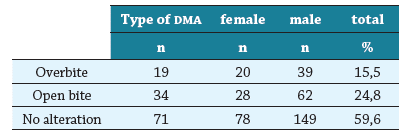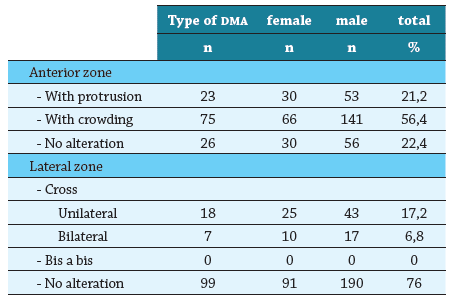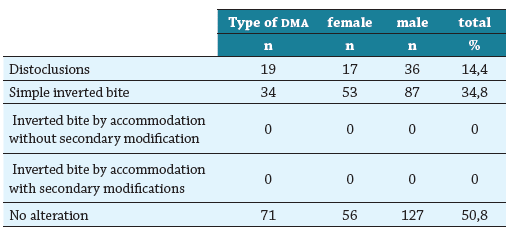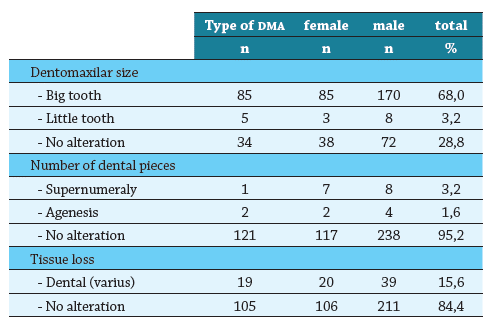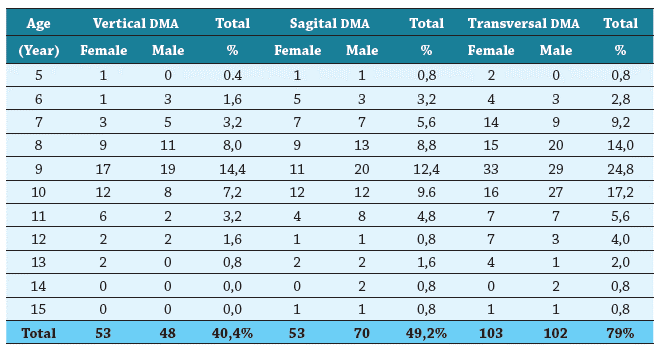INTRODUCTION
Dentomaxilar anomalies (DMA) constitute a public health problem because it is one of the most prevalent oral pathologies in Chile and in the rest of the world from the epidemiological point of view.
DMA correspond to the third most prevalent oral pathology in the Chilean population after dental caries and gingival or periodontal diseases. 1-8
DMA correspond to a group of alterations in the development of the jaws that frequently appear with altered dental position that affect the shape, function and aesthetics of the stomatognathic system, whose symptoms include changes in the numbers, shapes and structures of the teeth. 3-4,9-11
The etiology is multifactorial; therefore, DMA may be the result of one or more alterations, which include hereditary factors, alterations during the development stage, alteration of eruption and exfoliation patterns of developing teeth, environmental factors, among others. In the environmental factors are stomatognathic dysfunctions or parafunctions, also called Non-physiological oral habits. 4,6,8,9,12
These anomalies affect the aesthetics and functionality of the stomatognathic system and constitute the immediate cause of the loss of the harmonic relationship between the jaws and teeth, many of these anomalies are progressive and can transcend to the adult life in the interpersonal relationships, they can develop a feeling of shame about their dental appearance, feeling shy in social situations, even losing job opportunities, which translates into discontent, deterioration in the quality of life, social and functional limitations. 2,9,10,13
Orthodontics is the branch of dentistry that is responsible for preventing, diagnosing, intercepting, and treating dental malpositions and/or maxillofacial disorders. When appear the first signs of the disease we begin to interpose barriers to prevent its unfavorable evolution, all of them are interceptive orthodontic treatment. Is estimated that the need for posterior orthodontic treatment is reduced, therefore, early treatment is recommended to achieve the greatest amount of benefits for the patient, including better use of growth potential, less need for extractions, more limited fixed appliances treatments, leading to better and more stable over time, even orthognathic surgery could be avoid
From an epidemiological point of view, interceptive orthodontics turns out to be the most optimal treatment option, since it allows to control and treat these anomalies at their least serious moment, enhancing the success of the treatment. 5,14-18
The Bonns school postulated a classification where DMA are grouped into six main groups: three groups of intermaxillary DMA and three groups of intramaxillary DMA. In Chile, the biogenetic classification has been modified by the Department of Dentomaxilar Orthopedics of the University of Chile since 1965, which is based on the Bonn classification. The classification gains high value for making diagnoses of epidemiological utility. 3,4,12:
Intermaxillary anomalies: Vertical direction: open bite and overbite; Transverse direction: bis to bis bite, unilateral cross bite and bilateral cross bite; Sagittal: inverted Simple bite, accommodation inverted bite without secondary alteration, accommodation inverted bite with secondary alteration and distoclusions. Intramaxillary anomalies: Alterations of dental size, alterations in the number of pieces and alterations due to loss of dental tissue.
The success of the treatments also depends on the resources, the management and the ability to optimize both aspects. Knowledge the number of patients to be treated and, above all, the type of the anomalies should be treated would be important for planning and managment resources. It is extremely important to make an epidemiological diagnosis of DMA in a specific population. 7,19
In our country, there is no national study that allows establishing real data on the prevalence of DMA. The review of the available studies, most of them carried out in the Metropolitan Region, provides only local information, which cannot be extrapolated to the entire country due to the great diversity of these studies designs, the great variability between the age groups, the size and selection of the samples, etc. 20
The objective of this work is to determine the frequency of DMA present in patients treated in the Orthodontic Specialty of the Dental Specialties Service (DSS) of the Barros Luco Trudeau Healthcare Complex in Santiago, Chile. Applying a standardized measurement methodology to be able to compare with other studied populations.
MATERIALS AND METHODS
Research Design: exploratory, descriptive, and cross-sectional.
Location: it was carried out in the Dental Specialties Service (DSS) in the Orthodontic area, in the Barros Luco Trudeau Healthcare Complex, Santiago, Metropolitan Region, Chile.
This complex serves several districts that belong to the South Metropolitan area. The study was carried out between the months of April and September of the year 2019.
Procedure: Two professional dentist examiners were chosen, who were calibrated through a specific course for this purpose. A pilot sample consisting of 30 patients, randomly selected with properly diagnosed DMAs. These samples were examined by both dentists independently and for their respective classification (there was no contact between them during this procedure). The samples were coded and randomized to each of the calibrators.
Population: patients in orthodontics treatment in the DSS. Inclusion criteria: Pediatric patients in orthodontic treatment in DSS, patients with DMA in one or more senses of space. Exclusion criteria: Patients with bad behavior, syndromic patients.
Sample: The total sample consisted of 250 pediatric patients with DMA in an age range of 5 to 15 years, 124 female patients and 126 male patients.
Data collection: the same clinical file that the patients had realized during their orthodontic treatment, the realization of this file consisted of an anamnesis of the patients that records dental information, including the patient oral habits, followed by a clinical examination.
The collected data were tabulated in the Excel® program. The classification used in this study is the Bonns biogenetics, modified by the department of dentomaxilar orthopedics at the Faculty of Dentistry of the University of Chile 3,4,12
Statistical tests: calibration between subjects was performed using the Kappa test.
The frequency of cases was estimated as the division between a specific type of DMA over the total DMA 20. The level of significance used was a<0.06.
Ethical aspects: It was approved by the Barros Luco Trudeau Healthcare Complex ethics committee with resolution number 3972 dated August 26, 2019.
RESULTS
The total sample consisted of 250 pediatric patients with DMA of which 49,6% was female and 50,4% male. The distribution of the sample by age denotes that most of the children were 9 years old, represented by 28,4%, followed by the age of 10 years corresponding to 20,4% and, thirdly the age of 8 years corresponding to 19,2%.
Analyzing the vertical anomalies, 24,8% presented an open bite and 15,5% an overbite. The most frequent vertical DMA in both genders is the open bite where the female gender predominates over the male. (Table 1)
In relation to the transverse anomalies, it was observed that 56,4% correspond to the anterior area with dental crowding and 21,2% with protrusion. DMA with dental crowding is the most frequent in both genders, but it is more prevalent in the female gender. In the lateral area, 17,2% correspond to unilateral crossbite, 6,8% bilateral crossbite. The unilateral crossbite DMA is the most frequent in both genders, with the masculine gender prevailing. (Table 2)
The intermaxillary anomalies 34,8% presented inverted simple bite, 14,4% presented distoclusions, the most frequent DMA in both sexes is the inverted simple bite where the male gender predominates over the female. (Table 3)
With respect to intramaxillary DMA in relation to the dentomaxilar size, 68,0% corresponds to a large tooth and 3,2% to a small tooth.
According to the alteration by number of teeth, it was found 3,2% corresponds to supernumeraries and 1,6% to agenesis. The loss of dental tissue corresponds to 15,6%. The most frequent DMA is the alteration of dentoalveolar size by large tooth and its distribution by genders is symmetrical. (Table 4)
Finally, remembering that for each examined can be more than one DMA, it is observed that of all the intermaxillary DMAs in the three directions of space, the most frequent is in the transverse direction with 79,9%, followed by 49,2 % in the sagittal direction and finally 40,4% in the vertical direction it is also evident that at the age of 9 years it is the most frequent with respect to the total of the DMA in the three directions of space. In the vertical and sagittal sense, the masculine gender predominates over the female and in the transversal sense, the female gender predominates over the masculine. (Table 5)
DISCUSSION
There are no previous studies corresponding to the sample observed in this work, it is pertinent to analyze the national studies in the Metropolitan Region that resemble ours.
In 1972 Richards et al already revealed that 65% to 72,6% of Chilean children between 5 and 14 years old had some type of DMA. This study is similar to the age range of our study however, he maintains a different methodology in the rest of its research compared to ours. 21
In 2005 in the southern area of the Metropolitan Region, Carreño et al found that 29,3% of the children between the ages of 2 and 6 had interceptable DMA. The most prevalent DMA were open bite with 17,1% and compressions with 6,65%. Our study also measures patients in the southern area of the metropolitan region, among our results in patients with DMA, the most frequent is in the transverse direction due to compressions with 79%, causing cross bite and crowding in the anterior sector and in the lateral sector, this is followed by sagittal DMA with 49,2% where the most frequent corresponding to the inverted simple bite. 22
Scott and Calderón, in 2009, carried out a study at the primary level of health care within the southeast metropolitan service, where they measure the implementation of the "norms for the prevention and interception of dentomaxilar anomalies" in 1998, the study determined that only 9,3% of the population enrolled in the primary health service in the South had access to interceptive orthodontic treatment. This data is relevant when considering that the present study measures the frequency of DMA in the population extrapolated to the current southern metropolitan health area, specifically within the Barros Luco Trudeau Hospital. 23
Pardo et al carried a study in 2018 in children from 3 and 10 years of age, with a total of 106 patients attended in the clinic of the child and adolescent of 4th year of the faculty of dentistry of the University of Chile, which yielded a 45,1% prevalence of DMA in any of the 3 senses of space. In the case of the present study, children between 5 and 15 years old, represented in a total of 250 patients, had 100% DMA due to being in orthodontic treatment, so our results distribute the frequencies of DMA according to the direction of the space they affect. Both studies used modified Bonn's Biogenetic classification and a more similar methodology compared to the rest of the studies. 12
As can be seen in this study, DMA affects a high percentage of the population under 15 years old, with a different degree of commitment, since there is not enough infrastructure or human resources in the country to provide them with an adequate solution. 20
In conclusion, with the results, it was possible to analyze and compare the different frequencies of DMA, present in all the patients in the sample, with respect to the type of DMA, age and gender, mainly. However, we consider ourselves in debt for not being able to measure the real prevalence of DMA, since it requires access to a universal sample that includes even several undiagnosed patients. It is worth mentioning that this debt is extrapolated at the national level since there is no updated literature on the prevalence of DMA through Chile, which is important to determine the need for treatment and thus be able to provide adequate coverage.














